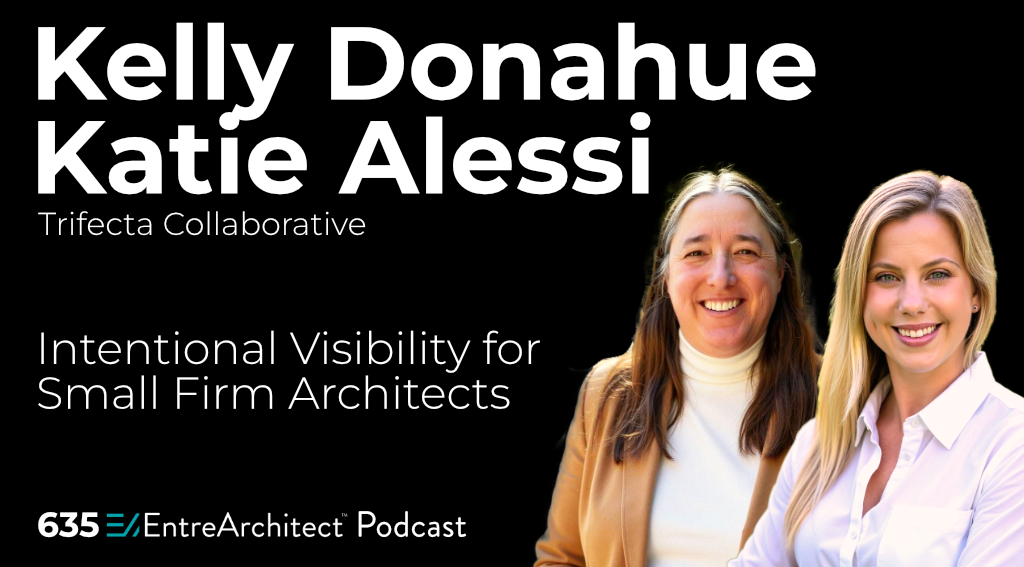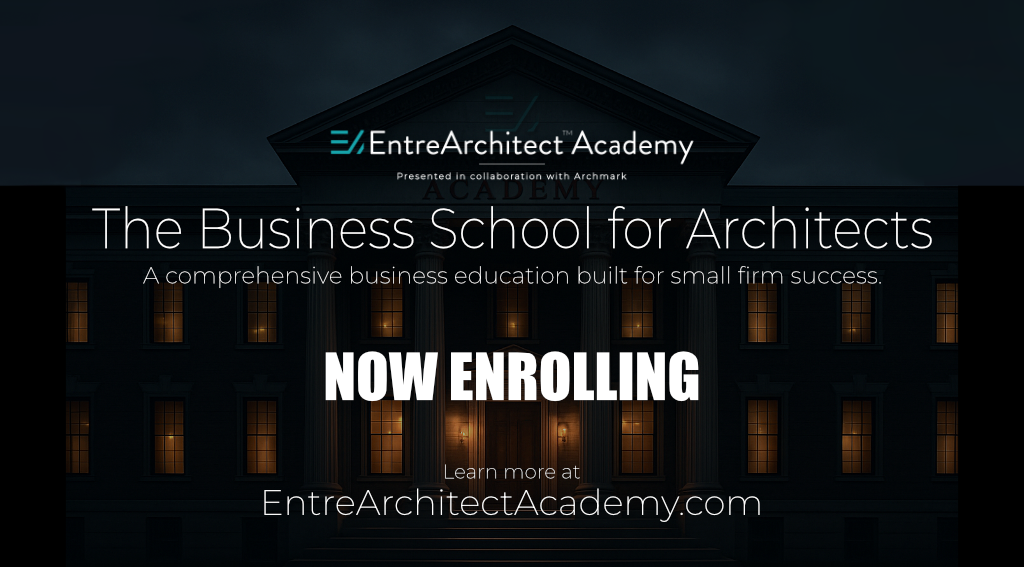
In a recent conversation with Katie Alessi and Kelly Donahue, I was reminded just how much opportunity sits in front of small firm architects when we embrace “intentional visibility”. Katie and Kelly bring a combined 45 years of marketing and communications experience in the AEC industry. During our discussion, they broke down why so many firms struggle to be seen, what architects often misunderstand about marketing and PR, and how simple, consistent actions can radically change your visibility in the marketplace.
If you want to listen to the full conversation, you’ll find it at https://entrearchitect.com/635.
Understanding What Visibility Really Means
Traditional marketing in architecture has always carried some tension. Many of us were trained to believe that great work alone leads to the next great project. For generations, architects didn’t market at all. We weren’t allowed to. And even today, the idea of marketing can feel uncomfortable for small firms that are already stretched thin.
But Katie and Kelly define intentional visibility in a way that reframes the entire idea. Visibility isn’t volume. It isn’t mass marketing. It isn’t trying to be everywhere. It’s about clarity. It’s about knowing exactly who your ideal client is and designing a focused, strategic plan to get in front of them in meaningful ways. It’s about developing targeted messages that land with the people who actually make decisions. It’s being seen by the right people, at the right time, in the right way.
That clarity is what most small firms are missing. And it’s costing real opportunities.
Why Small Firms Struggle to Be Seen
Time is the first barrier. Small firm architects are juggling dozens of roles at once. When your days are filled with drawings, meetings, clients, operations, and everything else, marketing becomes something you squeeze in when you can. And when you only market reactively, you stay stuck in the cycle of “hope-based marketing”, a phrase Katie and Kelly use often.
Hope-based marketing is exactly what it sounds like. You finish a project, you’re proud of the work, and you hope the next phone call comes in. You hope someone saw your latest renovation. You hope someone somewhere is talking about your firm. But hope is not a strategy.
The other barrier is focus. Many small firms attend every event they can, post sporadically on social media, and maintain websites that try to speak to everyone at once. But without a target, every effort is diluted. Katie shared the story of a small New Hampshire firm attending countless events that had nothing to do with their ideal clients. They were putting in the effort but not getting results because they weren’t speaking to the right people.
Time and lack of focus feed each other. When you try to do everything, you feel overwhelmed. When you feel overwhelmed, you pull back. When you pull back, nothing moves forward.
The Starting Point: Know Your Ideal Client
Both Katie and Kelly emphasize this as the foundation. Without clarity on who you want to serve, every marketing or PR effort becomes muddy. When you know your ideal client, everything becomes easier: the message, the platform, the strategy, even your fees.
For many architects, the idea of niching feels limiting. We have broad skills. We love being generalists. And we want to feel prepared when the market shifts. But you don’t have to stop being a generalist to communicate like an expert. You can design many building types while still marketing one of them intentionally.
Katie framed this perfectly: if you’re trying to speak to police commissioners, university presidents, and homeowners with the same message, none of them will hear you. They each care about different things. They each have distinct pressures and needs. And they will not connect with broad, general messaging.
When you speak directly to one ideal client, you earn authority. And when you earn authority, you can raise your fees because people trust your expertise.
Building a Strategic Roadmap
Architects understand planning better than most professions. Yet many of us skip that same discipline in our business development efforts. Katie and Kelly use a simple, month-by-month marketing roadmap with their clients to help them stay focused and consistent.
It begins with setting goals:
• What projects do you want to win?
• What building types energize you?
• How many new clients do you want this year?
• Where do you want the firm to be in 12 to 18 months?
Once the goals are set, the roadmap is about clear steps, not a flood of activity. For one retail-focused firm, they identified the correct industry organization, submitted a conference speaking abstract, placed a targeted publication ad, created blog content, and then sent a highly focused newsletter. Small steps, spread across months, created momentum.
This isn’t complicated work. It simply requires intention and consistency.
Marketing, PR, and Branding: How They Work Together
Many architects treat these as interchangeable terms. They’re not. And understanding the differences can help you make better decisions.
Marketing is the process of planning and deploying tactics that put your ideas, projects, and expertise in front of your audience. Social media, website content, newsletters, conference engagement, speaking, advertisements, and targeted outreach all sit here.
Branding is the expression of your identity: the visuals, the voice, and the message that give your firm its personality and recognizability. Strong branding reinforces every marketing activity.
PR is the craft of shaping stories that resonate, communicating clearly, and using the most effective channels to amplify your message. PR helps your story reach beyond your existing circles.
The key insight is that none of these live in isolation. A strong roadmap blends them naturally. A media announcement becomes a social post. A speaking engagement turns into an article. A project milestone becomes a newsletter story and a local-media pitch. One message, expressed in multiple ways, reinforces visibility.
Low Hanging Fruit Architects Often Miss
Katie and Kelly said the simplest, easiest, zero-cost action architects can take is documenting their work in real time using the phone in their pocket. Ten seconds on a job site. A quick video of a detail. A short caption about progress. This kind of authentic content connects directly to your expertise and keeps your name top of mind.
But most architects resist it. They overthink it or dismiss it as too simple. Yet the firms who embrace it see results.
Another overlooked opportunity is partnering with your project team. Engineers, construction managers, and consultants have their own audiences and networks. When you share each other’s content, co-present at events, or tell the story together, your visibility multiplies.
Human Connection Still Matters
We also talked about AI and how it’s reshaping marketing. While AI can draft content, spark ideas, or help you refine a message, it cannot replace your voice. And clients know when something feels generic. In fact, as AI-generated content becomes more common, authenticity will matter even more. The architects who show up as real humans will stand out.
If you want to future-proof your visibility, lean into the relationships, the personal insights, the human stories of your work. AI can support your process, but it shouldn’t speak for you.
Business Development Is Part of the Job
Marketing and PR only work when they connect to actual relationships. Busy architects often resist the idea of networking, but Katie shared her own discipline: even with a young family and a heavy workload, she commits to attending two meaningful community events each month. She connects with every person she speaks to. Then she follows up intentionally.
Small, consistent actions build relationships. Relationships build opportunities.
What You Can Do Today
I asked both Katie and Kelly to share one action a small firm architect can take today to build a better business for tomorrow.
Kelly’s advice was to identify a narrow audience and engage them with something creative, consistent, and personal. One architect she works with emails 50 local real estate agents once a quarter with a simple, quirky update. The results have been powerful.
Katie emphasized having a few commitments each month and sticking to them. Whether it’s posting on social media, attending an event, or sending a newsletter, consistency wins.
Start Now
Intentional visibility doesn’t require a huge budget or a marketing department. It requires focus, discipline, and clarity. It requires knowing your ideal client and building a plan to reach them. It requires steady, authentic communication that helps people understand the problems you solve.
If you build buildings by design, you can build a marketing plan the same way. And if you want to dive deeper into these ideas, you’ll find the full conversation with Katie and Kelly at https://entrearchitect.com/635.

Leave a Reply